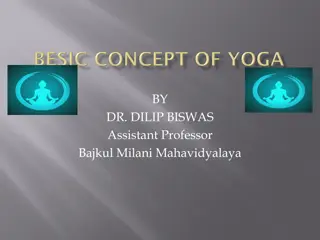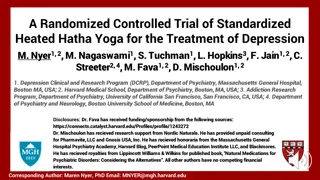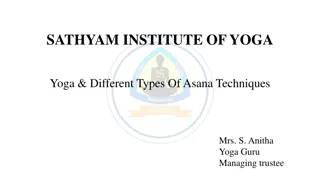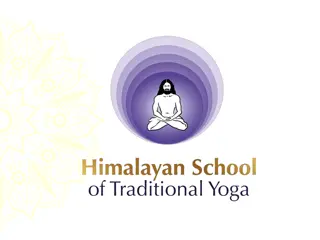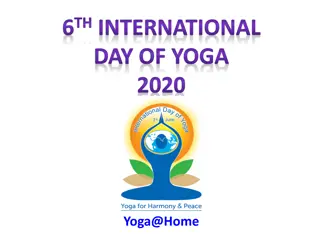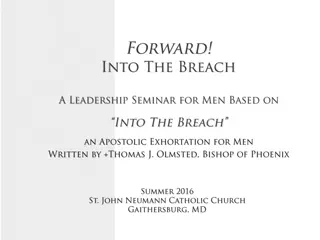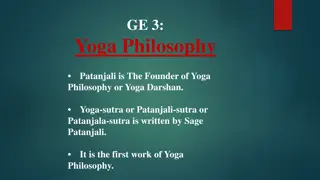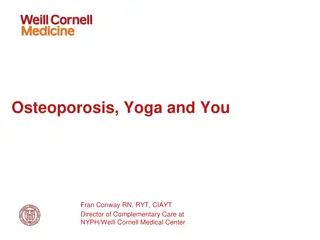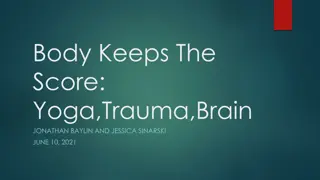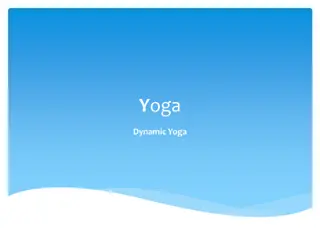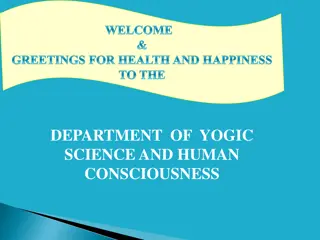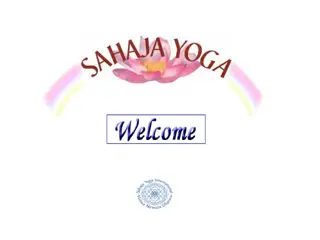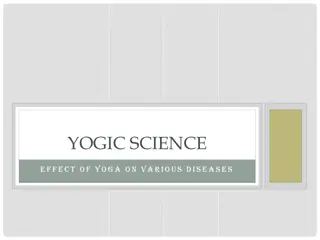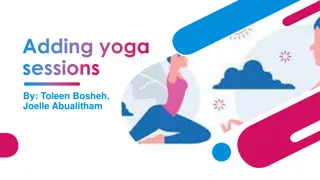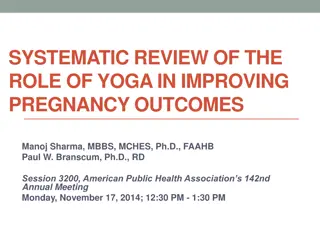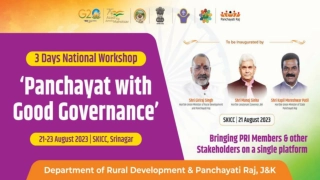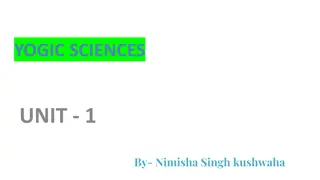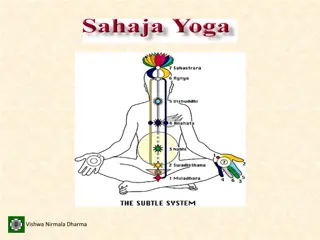Understanding Asceticism, Hatha Yoga, Tantra, and Kashmir Shaivism
Asceticism, originating as tapas for purification, led to the development of Hatha Yoga focusing on physical practices. Early Hatha Yoga aimed to conserve life essence, later evolving to include Kundalini and chakras visualization. The practice involves mudras and energy channeling techniques.
Uploaded on Sep 28, 2024 | 0 Views
Download Presentation

Please find below an Image/Link to download the presentation.
The content on the website is provided AS IS for your information and personal use only. It may not be sold, licensed, or shared on other websites without obtaining consent from the author. Download presentation by click this link. If you encounter any issues during the download, it is possible that the publisher has removed the file from their server.
E N D
Presentation Transcript
Review since the midterm: Asceticism, hatha yoga, tantra and Kashmir Shaivism
Asceticism In the early traditions, asceticism is usually identified as tapas. It is a heat generating practice that is intended to purify the mind/ body complex in order to attain power and/ or higher states of consciousness.
Although the ascetics who used these techniques were also associated with the practice of yoga, the physical techniques themselves were not. Early ha hayoga is a codification of the physical practices of these ascetics. -- J ames Mallinson, yoga scholar
The origins of Hatha Yoga (900-1000 CE)
Haha: to treat violently, to force or oppress Ha ha yoga: the yoga of forceful exertion
Early Haha Yoga In its earliest formulations, ha ha was used to raise and conserve the physical essence of life, identified in men as bindu (semen), which is otherwise constantly dripping downward from a store in the head and being expended. (The female equivalent, mentioned only occasionally in our sources, is rajas, menstrual fluid.) --J ames Mallinson Brill Encyclopedia of Hinduism
Later Haha philosophy: The emphasis on bindu is replaced with the visualization of kundalini and cakras This tantric visualization is combined with mudras, physical techniques designed to channel energy in the body
Haha yoga represents the yogic body as a sealed hydraulic system within which vital fluids may be channeled upward as they are refined into nectar through the heat of asceticism. -- David Gordon White
Hahayogapradpik Four chapters: -asana -pranayama: breathing techniques -mudra: physical techniques to channel energy in the body the distinguishing characteristic of ha ha yoga prior to the Ha hayogaprad pik -sam dhi: a state of unity attained through a practice of visualization of subtle energy
Hahayogapradpik and Yoga Stras 4 chapters, sutra style texts Both texts drew from an existent body of practices to create a codified text. Both texts became the classical texts on yoga for that era. Both texts combine practices and philosophies that are held separate in other texts. Both are non-sectarian
Haha Yoga and Yoga Stras There is no opposition between Pata jali s yoga and the techniques in early Ha ha Yoga texts; the practices of Ha ha Yoga are supplementary to those of a gayoga (eightfold yoga, i.e. Pata jala Yoga). -J ames Mallinson
What is the difference between Haha Yoga and R ja Yoga? In the early texts Raja Yoga was equal to Sam dhi. It is an ultimate state to be attained and not indicative of a set of practices. Descriptions of mbhav Mudr omit the first 7 limbs of a gayoga and liken this state to R jayoga. The HYP declares that Ha ha and Raja Yogas are interdependent. Swami Vivekananda (1863-1902) also termed the Yoga of the Yoga S tras Raja Yoga and suggested that it was primarily mental practice.
Profound shifts in envisioning yoga between 400 & 1000 CE: Re-framing the goal and primary method of yoga: Yoga Sutra: Goal: kaivalya or aloneness, disentangling purusha from its misidentification with prakriti, the material world Primary method: samadhior absorbed concentration Hatha yoga: Goal: union, to realize our identity with the divine being whose body IS the material world Primary method: embodied practices such as asana, pranayama, mudra, mantra, etc.
There is overlap and continuity - there were bodily practices in Patanajali s yoga - the practices taught in the YS (including samadhi) are included in later yogas - medieval yogic systems continue to teach their own version of an eight-fold path Yoga - the Yoga Sutras refer to devotion to the Lord of - tantra continues to ground its metaphysics in the Samkhyan categories (tattvas)
But there is also a profound shift: - the gods and goddesses and the world that is their body are inscribed on the human body - liberation is a process of union that unfolds and is enacted within the human body - the human body is the necessary vehicle for liberation - the senses are the organs for the touch of the absolute - desire is utilized in service of liberation - new tattvas are added to the Samkhyan system to reframe the world as nondual in nature
The Yogavasistha: Composed in Kashmir 800-1250 CE A nondual text portraying yoga as a practice of self-inquiry
You should be ceaselessly engaged in the pursuit of this gentle inquiry: Who am I? What is the nature of this universe? It is this true inquiry alone that generates knowledge. -- The Yogavasistha
Why waste your life in futile austerities? Why not reach the state of the enlightened by inquiring into the very nature of human bondage and liberation? -- the Yogavasistha
The dreamlike nature of thoughtform is only realized by the intense practice of yoga. -- the Yogavasistha
The tantric teachings of Kashmir Shaivism
Abhinavagupta 950-1025 CE Kashmir (northern India) author of many texts on philosophy, tantric practice, and aesthetics synthesized all systems into tantra Abhinavagupta s student: Kshemaraja The Heart of Recognition 20 sutras summarizing this worldview written by Kshemaraja ca. 1050 CE
Consciousness, in Her freedom, brings about the attainment of the universe. -- Pratyabhijnahrdayam, sutra 1
Consciousness herself, having descended from the expanded state, becomes the mind, contracted by the objects of perception. -- Pratyabhijnahrdayam, sutra 5
That which is full of Consciousness, due to contraction of its powers, becomes a transmigratory soul, covered by impurities. -- Pratyabhijnahrdayam, sutra 9
When one is fully aware the mind itself becomes Consciousness by rising to the state of full expansion through inward-facing contemplation. -- Pratyabhijnahrdayam, sutra 13
The state of liberation while living is the unwavering experience of oneness with Consciousness, even while one perceives the body. -- Pratyabhijnahrdayam, sutra 16
The yoga of recognition: recognizing one s own awareness as the awareness of God recognizing one s own identity as Shiva/ Shakti recognizing all that is perceived as one s own body, the body of God
What is tantra? A worldview that ultimately spreads throughout Asia
Tantric practice aims at ritually gaining access to the energy of the godhead that created and controls the universe, then concentrating and internalizing that power in the body of the devotee. This turns the world and the body into channels of salvation, and a means of merging with the Absolute, but also grants tangible magical powers to the devotee, in this life, in the present. -- William Dalymple
The empowerment of the body, which means its divinization, is the most important quality in the tantric traditions. -- Gavin Flood, The Tantric Body
the tantric body
Definitions of yoga in hatha yoga and Kashmir Shaivism
Gorakantha, the founder of hatha yoga Yoga is defined as the unification of the many pairs of opposites, the unification of in-breath and out-breath, the unification of the sun and the moon, the unification of the individual self with the Supreme Self.
He who sees the entire universe as revolving inside of himself, who always knows the universe to be his own self due to his identity with it he is a yogi, a knower, a perfected being, a master. --Gorak an tha
Yoga is the realization that God and the self are not different. rad -tilaka 25.2
The realization of yoga is: identifying one s awareness with the awareness of God. -- Abhinavagupta
The ultimate goal of yoga is to identify one s own awareness with the awareness of God. -- Abhinavagupta


